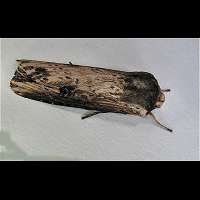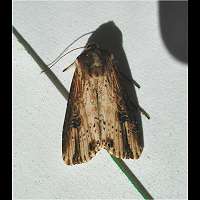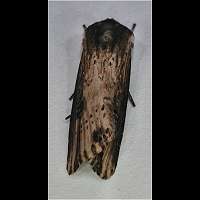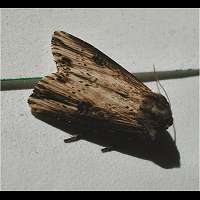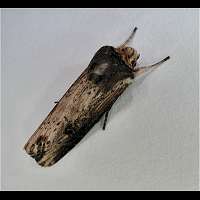Flame Axylia putris
It is virtually impossible to wrongly identify the Flame. It is coloured like wood with black patches. When resting the wings are curled around the body. The animal then really resembles a burnt chip of wood. Not many Owlet Moths assume this position when resting. Grassmoths and Footmen do rest in a similar position, but usually they are smaller and have a lighter colour. Flames which have just landed or are preparing for take off do sit in the usual Noctuid position. The wingspan varied from 30 to 36mm.
The eggs are being laid from June to late August. They are being deposited in large groups on the underside of a leaf of the hostplant. They hatch quickly, normally after about one week. The caterpillars usually feed by night only, but are sometimes seen during the day actively munching away at leaves. Very few animals already pupate in July and are seen as adult moths in August. This so-called autumn generation is very small though. Most caterpillars pupate in August. They dig a hole in the ground. Inside they spin a firm cocoon which is strengthened with earth and grains of sand. The pupa overwinters. The caterpillar is greyish green or greyish greenbrown and tapers towards the head. It grows to a length of 34 to 38mm. It feeds on a series of green plants, usually low growing, such as docks, dandelions, bedstraws, dead-nettles, goosefoots and hound's tongues.
The Flame is on the wing from mid-May to mid-July. From mid-July to the end of August there might be a very small second generation. The Flame flies and feeds during the night only. It is seen in the evening hours on flowers in the garden, though. Is attracted to light and to sugar. Has no preferencesd when it comes to soil. Because of the foodplants it prefers open areas, including farmland, hedges, parks, gardens and roughs. A common species in England, Wales and Ireland. A local species in both southern Scotland and the Hebrides.
It is virtually impossible to wrongly identify the Flame. It is coloured like wood with black patches. When resting the wings are curled around the body. The animal then really resembles a burnt chip of wood. Not many Owlet Moths assume this position when resting. Grassmoths and Footmen do rest in a similar position, but usually they are smaller and have a lighter colour. Flames which have just landed or are preparing for take off do sit in the usual Noctuid position. The wingspan varied from 30 to 36mm.
The eggs are being laid from June to late August. They are being deposited in large groups on the underside of a leaf of the hostplant. They hatch quickly, normally after about one week. The caterpillars usually feed by night only, but are sometimes seen during the day actively munching away at leaves. Very few animals already pupate in July and are seen as adult moths in August. This so-called autumn generation is very small though. Most caterpillars pupate in August. They dig a hole in the ground. Inside they spin a firm cocoon which is strengthened with earth and grains of sand. The pupa overwinters. The caterpillar is greyish green or greyish greenbrown and tapers towards the head. It grows to a length of 34 to 38mm. It feeds on a series of green plants, usually low growing, such as docks, dandelions, bedstraws, dead-nettles, goosefoots and hound's tongues.
The Flame is on the wing from mid-May to mid-July. From mid-July to the end of August there might be a very small second generation. The Flame flies and feeds during the night only. It is seen in the evening hours on flowers in the garden, though. Is attracted to light and to sugar. Has no preferencesd when it comes to soil. Because of the foodplants it prefers open areas, including farmland, hedges, parks, gardens and roughs. A common species in England, Wales and Ireland. A local species in both southern Scotland and the Hebrides.

